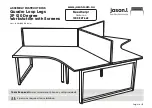
LOSS MODE
OVERVIEW
TEST PROCEDURES
27
LOSS MODE
– After a fiber cable has been installed and terminated, optical loss measurements can be used to measure the quality
of a fiber link. A comparison between the actual power measurement and the reference value determines how much optical power is
lost through the link.
LOSS MODE can be performed with all models of
TEST PROCEDURE
This procedure demonstrates a test procedure that assumes that the fiber link was properly designed, installed, and tested according
to industry standard requirements and recommended “best practices” as shown below:
For non-standard link configurations, such as a patch panel on one end, or “home run” (i.e. no patch panels), technicians may need to
adjust their test procedure and reference method accordingly.
FIBER OWL 7 optical power meter
and standalone light source (purchased
separately or as part of a certification test kit).
Patch
Panel
Link Under Test
Patch
Panel
LOSS MODE
– After a fiber cable has been installed and terminated, optical loss measurements can be used to measure the quality
of a fiber link. A comparison between the actual power measurement and the reference value determines how much optical power is
lost through the link.
LOSS MODE can be performed with all models of
TEST PROCEDURE
This procedure demonstrates a test procedure that assumes that the fiber link was properly designed, installed, and tested according
to industry standard requirements and recommended “best practices” as shown below:
For non-standard link configurations, such as a patch panel on one end, or “home run” (i.e. no patch panels), technicians may need to
adjust their test procedure and reference method accordingly.
FIBER OWL 7 optical power meter
and standalone light source (purchased
separately or as part of a certification test kit).
LOSS MODE
– After a fiber cable has been installed and terminated, optical loss measurements can be used to measure the quality
of a fiber link. A comparison between the actual power measurement and the reference value determines how much optical power is
lost through the link.
LOSS MODE can be performed with all models of
TEST PROCEDURE
This procedure demonstrates a test procedure that assumes that the fiber link was properly designed, installed, and tested according
to industry standard requirements and recommended “best practices” as shown below:
For non-standard link configurations, such as a patch panel on one end, or “home run” (i.e. no patch panels), technicians may need to
adjust their test procedure and reference method accordingly.
FIBER OWL 7 optical power meter
and standalone light source (purchased
separately or as part of a certification test kit).
Link
Under
Test
Patch
Cable
(to active
equipment)
LOSS MODE
– After a fiber cable has been installed and terminated, optical loss measurements can be used to measure the quality
of a fiber link. A comparison between the actual power measurement and the reference value determines how much optical power is
lost through the link.
LOSS MODE can be performed with all models of
TEST PROCEDURE
This procedure demonstrates a test procedure that assumes that the fiber link was properly designed, installed, and tested according
to industry standard requirements and recommended “best practices” as shown below:
For non-standard link configurations, such as a patch panel on one end, or “home run” (i.e. no patch panels), technicians may need to
adjust their test procedure and reference method accordingly.
FIBER OWL 7 optical power meter
and standalone light source (purchased
separately or as part of a certification test kit).
LOSS MODE
– After a fiber cable has been installed and terminated, optical loss measurements can be used to measure the quality
of a fiber link. A comparison between the actual power measurement and the reference value determines how much optical power is
lost through the link.
LOSS MODE can be performed with all models of
TEST PROCEDURE
This procedure demonstrates a test procedure that assumes that the fiber link was properly designed, installed, and tested according
to industry standard requirements and recommended “best practices” as shown below:
For non-standard link configurations, such as a patch panel on one end, or “home run” (i.e. no patch panels), technicians may need to
adjust their test procedure and reference method accordingly.
FIBER OWL 7 optical power meter
and standalone light source (purchased
separately or as part of a certification test kit).
Interconnection
LOSS MODE
– After a fiber cable has been installed and terminated, optical loss measurements can be used to measure the quality
of a fiber link. A comparison between the actual power measurement and the reference value determines how much optical power is
lost through the link.
LOSS MODE can be performed with all models of
TEST PROCEDURE
This procedure demonstrates a test procedure that assumes that the fiber link was properly designed, installed, and tested according
to industry standard requirements and recommended “best practices” as shown below:
For non-standard link configurations, such as a patch panel on one end, or “home run” (i.e. no patch panels), technicians may need to
adjust their test procedure and reference method accordingly.
FIBER OWL 7 optical power meter
and standalone light source (purchased
separately or as part of a certification test kit).
an interconnection (i.e. patch panel or wall outlet)
on both ends of the link
1-jumper reference method
(no adapters between meter and source)
LOSS MODE
SOURCE
Using a meter and a source, each
individual fiber is separately for loss.
METER
Optical Source
WaveSource Pro
AUTO
PORT
MOD
CW
TEST
SAVE
LOSS
FIBER#1
ACME CORP / HQ WEST
M=COMPUTER ROOM I=NETWORK HUB 3
Length:
100m WAVE:
EIA/TIA 568C.3 CON: 2
INDOOR SM SPL: 2
1310
ENTER
-0.24
1310nm
dB
-0.23
1550nm
dB
Содержание 7 LITE Series
Страница 3: ...3 This page intentionally left blank ...
















































